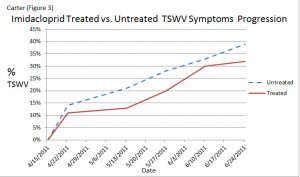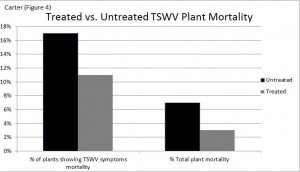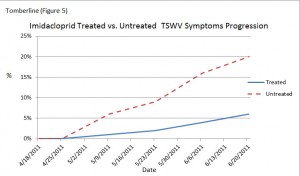Evaluating Control of Tomato Spotted Wilt Virus in Tobacco using Imidacloprid
Introduction – Tomato spotted wilt virus (TSWV) is the most limiting factor in tobacco production, and hence, profitability in Georgia. UGA tobacco pathologists estimate tomato spotted wilt virus causes an average annual (1995-2011) 36% stand loss and 18.5% yield reduction. Past research has shown that the best control program for spotted wilt is a combination of imidcacloprid and Actigard. The purpose of this research was to evaluate the effectiveness of imidacloprid. Data shows a 20% reduction in spotted wilt is needed for both statistical and economic benefit. There have always been some inconsistencies with imidacloprid treatments, but the specific reasons for each case are unknown. Continuous evaluation of treatments is necessary to maintain confidence in the spotted wilt control program. Evaluations are based on comparing performance of treated and untreated plants at several locations each year. Based on over 100 trials conducted between 1997 and 2011 there is a 94% chance of benefit with an average level of spotted wilt control of 31% when treating plants produced in float bed plant houses. In addition to monitoring treatment performance, the spotted wilt incidence in untreated plants is being used to develop a predictive model for this disease.
Objective(s) – There are two objectives in this work: To reevaluate the effectiveness of Imidacloprid and to evaluate Imidacloprid as a treatment for controlling TSWV.
Implementation – Two trials were conducted in Appling County as part of an 18 location study in Georgia. The Carter plot had four replications and the Tomberlin plot had five. In each replication there were an equal number of treated and untreated plants. Untreated seedlings were obtained by covering trays with plastic when admire was applied. Treated and untreated seedlings were planted on opposite sides of a skip row for each rep. Plants were evaluated each week for 12 weeks to determine the percent of spotted wilt symptoms.
Results and Discussion – In the Carter plot there was 39% spotted wilt symptoms in the untreated plants. 17% of those plants had died by harvest resulting in 7% mortality of the total untreated plants. There was 33% spotted wilt symptoms in the treated plants. 11% of the diseased plants had died by harvest resulting in 3% mortality in the treated plants. (Figures 3 and 4)
Comparing the spotted wilt incidence in untreated and treated plants there was only 16% control in the Carter plot which would not cover the cost of the imidacloprid application. The small increase in disease control and plant survival in the treated plot was not significant (p=0.005). Thirty five percent of the spotted wilt occurred during the first two weeks after planting (Figures 3 and 4).
In the Tomberlin plot there was 21% spotted wilt syptoms in the untreated plants. 46% of these plants died, resulting in 9.2% mortality of the total untreated plants. (Figures 5 and 6)
There was 7% spotted wilt symptoms in the treated plants. 21% of these infected plants died, resulting in a mortality rate of only 1.2% of the treated plants. Comparing the spotted wilt incidence in untreated and treated plants there was 66.3% control in the Tomberlin plot which was significant (p=0.001). Thirty seven percent of the spotted wilt developed between the middle of May and beginning of June (Figures 5 and 6).
Conclusions/Evaluations – We continue to have farmers not getting the amount of control needed from imidacloprid treatments. The inconsistencies with imidacloprid treatments have been noted and the specific reasons are unknown at this time. Among the possible reasons are improper rate, poor application, failure to rinse off properly, undefined field conditions at the time of planting, etc. One location in Appling County had 16% control and the other had 66.3% control when comparing the treated plants to the untreated. In over 100 trials conducted between 1997 and 2011 the percent control of spotted wilt with imidacloprid ranged from less than 10% to greater than 60%. The average control was 31%. More work will have to be done to determine what leads to the occasional failures with imidacloprid. It is clear that using imidacloprid will reduce spotted wilt in tobacco.



